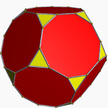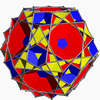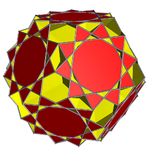Great dodecicosahedron
| Great dodecicosahedron | |
|---|---|
 | |
| Type | Uniform star polyhedron |
| Elements | F = 32, E = 120 V = 60 (χ = −28) |
| Faces by sides | 20{6}+12{10/3} |
| Wythoff symbol | 3 5/3 (3/2 5/2) | |
| Symmetry group | Ih, [5,3], *532 |
| Index references | U63, C79, W101 |
| Dual polyhedron | Great dodecicosacron |
| Vertex figure |  6.10/3.6/5.10/7 |
| Bowers acronym | Giddy |
In geometry, the great dodecicosahedron is a nonconvex uniform polyhedron, indexed as U63. Its vertex figure is a crossed quadrilateral.
It has a composite Wythoff symbol, 3 5/3 (3/2 5/2) |, requiring two different Schwarz triangles to generate it: (3 5/3 3/2) and (3 5/3 5/2). (3 5/3 3/2 | represents the great dodecicosahedron with an extra 12 {10/2} pentagons, and 3 5/3 5/2 | represents it with an extra 20 {6/2} triangles.)
Its vertex figure 6.10/3.6/5.10/7 is also ambiguous, having two clockwise and two counterclockwise faces around each vertex.
Related polyhedra
It shares its vertex arrangement with the truncated dodecahedron. It additionally shares its edge arrangement with the great icosicosidodecahedron (having the hexagonal faces in common) and the great ditrigonal dodecicosidodecahedron (having the decagrammic faces in common).
 Truncated dodecahedron |
 Great icosicosidodecahedron |
 Great ditrigonal dodecicosidodecahedron |
 Great dodecicosahedron |
Filling
There is some controversy on how to colour the faces of this polyhedron. Although the common way to fill in a polygon is to just colour its whole interior, this can result in some filled regions hanging as membranes over empty space. Hence, the "neo filling" is sometimes used instead as a more accurate filling. In the neo filling, orientable polyhedra are filled traditionally, but non-orientable polyhedra have their faces filled with the modulo-2 method (only odd-density regions are filled in).[1]
 Traditional filling |
 "Neo filling" |